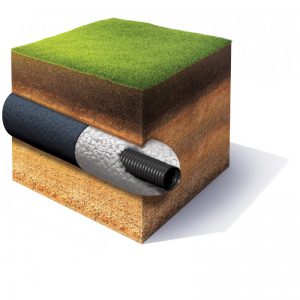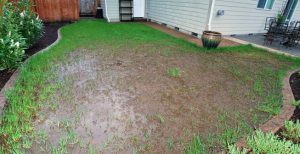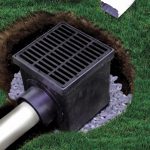A French drain is a gravel-filled trench that includes a perforated or slotted pipe. It is used to direct surface water or groundwater away from a specific area, such as a home’s foundation. French drains direct surface level water toward the lowest point and allow it to seep through the surface level gravel into the drain. This gravel also blocks the passage of excess debris. The water is then collected in the perforated pipe, running at the base of the drain, and directed away from the home and toward a more suitable area for daylighting or infiltration. French drains differ from typical surface drains because they collect water over the entire length of the drain instead of one particular spot.
How Does a French Drain Work?
 Remember that liquid always seeks out the lowest point it can reach along the easiest path, readily moving into empty pockets in loose soil. That’s the secret to a French drain: It provides a reliably easy path, creating a sunken channel that encourages water to percolate out of the surrounding soil and flow along a smooth course. Leveraging gravity is essential for a French drain to function properly, as it first forces water down from the surface and out of saturated soil, then pulls it along the downward-sloping pipe to the desired discharge point.
Remember that liquid always seeks out the lowest point it can reach along the easiest path, readily moving into empty pockets in loose soil. That’s the secret to a French drain: It provides a reliably easy path, creating a sunken channel that encourages water to percolate out of the surrounding soil and flow along a smooth course. Leveraging gravity is essential for a French drain to function properly, as it first forces water down from the surface and out of saturated soil, then pulls it along the downward-sloping pipe to the desired discharge point.
Where Should I Install a French Drain?
An easy way to site a French drain is to watch where water pools — especially if it sits for hours or days — after a rain. Some of the most common drainage problems homeowners face are:
Flooding in a backyard.
If heavy rains have left your yard with an unwanted water feature or the spring thaw has  saturated your yard, a French drain can help. Placing a French drain in this wet region allows the drain to collect unwanted water and redirect it to a safer location, giving you back your green space.
saturated your yard, a French drain can help. Placing a French drain in this wet region allows the drain to collect unwanted water and redirect it to a safer location, giving you back your green space.
Damage to an outdoor patio.
Your patio is a great source of pride and a meeting place for family and friends, but excess water can damage the area, deteriorate the pavers, and also create a breeding ground for mosquitoes, ruining your ability to spend time outdoors. A French drain can work as a shield, collecting water before it reaches the patio and diverting it away. This will eliminate the standing water that mosquitoes need.
Damage to a home’s foundation and low-level areas like a basement.
Check the walls in your basement. If you notice a musty smell or wet floor, you need a French drain immediately. A French drain can stop this water from ever reaching your home, protecting your basement from flooding and your home’s foundation from incurring additional damage.
What Do I Need to Know Beforehand?
 There are many factors to consider before installing a French drain. Slope is essential, as a downhill course must be downhill enough to keep water running along to its intended destination. Generally, a French drain should drop at least one percent in depth for every 100 feet of length.
There are many factors to consider before installing a French drain. Slope is essential, as a downhill course must be downhill enough to keep water running along to its intended destination. Generally, a French drain should drop at least one percent in depth for every 100 feet of length.
Other key issues to consider include:
French drain depth:
About 8 inches to 2 feet deep should be sufficient for many water-diverting projects, though related systems, such as those built around foundations and sub-ground living spaces, as well as the bases of retaining walls, may be deeper.
French drain aggregate:
The size of the gravel used can vary from pea gravel to larger pieces of river rock. If aggregate of different sizes is used, smaller pieces usually go closer to the pipe, while larger pieces sit closer to and on the surface.
French drain pipe length:
This really depends on a project’s specific elements. Of course, the pipe should be long enough to carry water from the underground areas where it collects to an end point, where it daylights.
French drain flow:
Slope is a big factor in maintaining a free flow of water, as is the aggregate placement and surrounding fabric to prevent debris from clogging the pipe.
For more information contact your local Wolf Creek Company representative.












Thanks for mentioning how a french drain should be around 2 feet deep. I also like how you said that is should be located on a slope. My husband and I are looking into a french drain; thanks for the post.